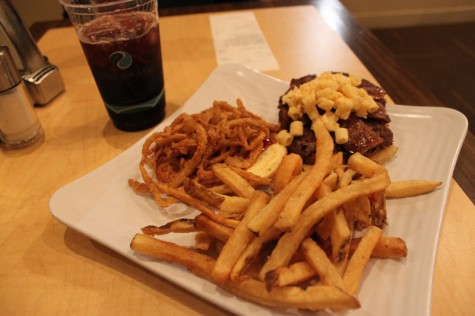The Cheeseburger Craze
Fast food attracts teenagers in spite of its health hazards.
January 8, 2015
Over the past few decades, fast food consumption has grown considerably. Unfortunately, America’s waistbands have reacted accordingly. Livestrong.com states that, in the 1950s, around 33 percent of Americans were overweight. However, according to the Centers for Disease Control and Prevention, 69 percent of Americans are currently overweight. In addition, the number of obese Americans has almost tripled, from about 10 percent of our population to about 35 percent.
Fast food consumption is especially prevalent in teenagers. A 2004 Harvard study determined three in 10 teens eat four to six meals a week at fast-food restaurants. This, of course, leads to a shortage of proper nutrients in a young teen’s system.

As reported by Sfgate.com, Vitamin C is an antioxidant used to battle disease, build tissue and remove plaque found in arteries. A typical “large” McDonalds serving of French fries contains 4.6 milligrams of vitamin C. One cup of raw broccoli contains 101.2 milligrams of Vitamin C, 22 times that of French fries. Vitamin E is an antioxidant used to counteract cancer and heart disease. Two pancakes and 2 tablespoons of pancake syrup contain .20 milligrams of Vitamin E. Two slices of whole-wheat toast and 2 tablespoons of peanut butter have 3.2 milligrams of Vitamin E, 16 times that of the pancakes and syrup.
The obvious question is why do teenagers consume excessive amounts of fast food, even though they already know the health hazards it presents? As stated on Bmsg.org, teens are more susceptible to fast food marketing because they spend a lot of time on electronic devices. This way, fast food manufacturers are easily able to manipulate them.
Fast food also attracts teenagers because of its low cost.
“[Fast food] is tempting because it’s so cheap,” junior Jack West said. “But it always ends up as being a waste of money, and it takes a toll on your health.”
The American Heart Association believes that teenagers will not stop consuming extreme amounts of fast food anytime soon, so they have compiled a list of ways to make fast food healthier. A few tips are to “skip the sides”, “go for the grilled” and “ask for a wheat bun”. Having said this, the AHA definitely encourages teenagers to skip the fast food altogether.
“Fast food makes you happy when it’s in your mouth,” West said. “Then, when you swallow, it’s like getting socks for Christmas.”







